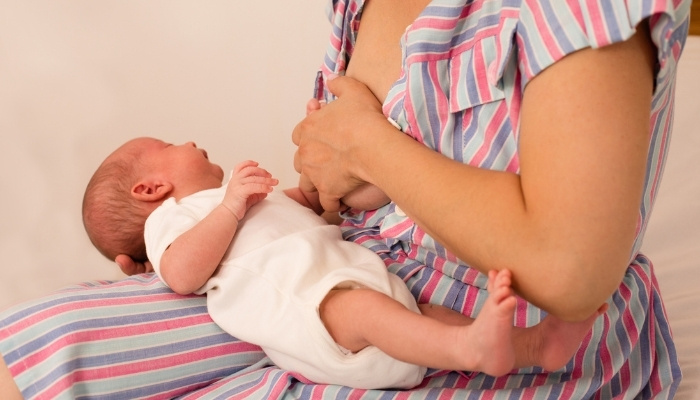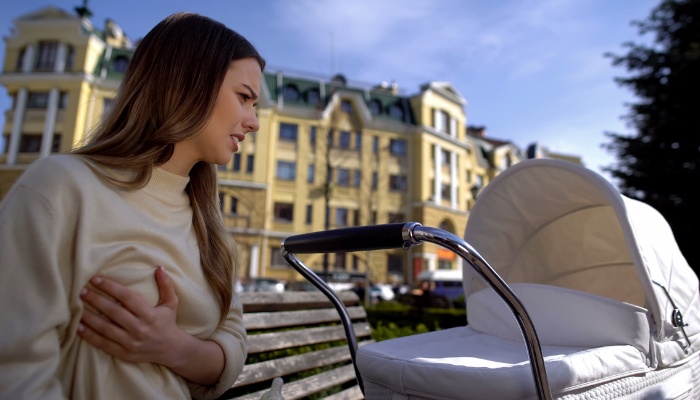If you experience temporary breast hardness while breastfeeding, prolonged nipple erection accompanied by pain could indicate a shallow latch and incorrect sucking technique.
For pumping mothers, poor positioning or incorrect flange sizes may be to blame.
The Office on Women’s Health advises:
“To find out if your baby is sucking only on your nipple, check what your nipple looks like when it comes out of your baby’s mouth.
Your nipple should not look flat or compressed. It should look round and long or the same shape as it was before the feeding.”
Unfortunately, my breastfeeding journey wasn’t an easy one, and my nipples suffered a lot.
However, I was able to learn a lot about proper techniques and the source of nipple pain while breastfeeding.
Now, I hope to be of some help to new mamas who may be facing the same struggles!
Table of Contents
Hard Nipples After Breastfeeding
Nipples are very sensitive and often get hard in response to stimulation. The pull from your baby’s suck can cause your nipples to become erect and hard.
However, if the hardness is associated with pain or does not go away after a feeding, it could be a sign of a latch or sucking problem.
Your nipples should look the same when you pull them out of your baby’s mouth as they did when you put them in.
If you are experiencing hard nipples for a while after a feeding, you may need to check your baby’s latch.
A shallow latch can cause a baby to compress the nipple and decrease blood flow resulting in hard, often tingly, and throbbing nipples.
What To Do
If you are experiencing chronic nipple hardness after breastfeeding, evaluate your baby’s latch to ensure they have a deep latch.
Their lips should be pursed with lips flanged outward like a fish, and the entire areola, not just the nipple, should be in their mouth.
If you have access to a lactation consultant, have them evaluate your baby’s latch.
They can help diagnose any problems you are having and give you the steps to correct them.
If you are pumping and experiencing nipple hardness, make sure you are using the right size flange.
A flange that is too big often causes nipple hardness. La Leche League has excellent information about flange fitting.
When To Be Concerned
If your nipples do not heal after proper latching, the discomfort worsens, or they begin to peel, crack, or bleed excessively, please see a lactation consultant or your doctor!
Normal Nipple Response to Breastfeeding
You may feel a slight tug on your nipples while breastfeeding, especially when your little one first latches.
Some mothers describe it as a “zing” that lasts a few seconds and then goes away. This is normal.
Your nipples may even be a little sore for a few days after you begin breastfeeding, especially for the first time.
Pain, however, is not a normal response.
Breastfeeding should not hurt. With proper positioning and latch-on techniques, you can expect little or no nipple soreness.
I don’t think I have ever paid as much attention to my nipples as I did when I was breastfeeding, but boy, am I glad that I did!
Your nipples can tell you a lot about your technique when it comes to feeding your baby.
Does Breastfeeding Change Your Nipples Permanently?
Breastfeeding certainly takes its toll on your nipples. The things we do as mothers, right? Don’t worry too much though.
You can usually expect your nipples to return to their original size and color once you are done breastfeeding.
Vasospasm Nipple
A vasospasm is what happens when the blood vessels that supply the nipple contract and reduce the blood flow to the nipple.
This can cause the nipples to look pale in color and often causes intense pain that can be worse when exposed to the cold.
When the blood returns, the nipple may look darker than usual.
Vasospasm Breastfeeding Symptoms
Breastfeeding women who experience vasospasms often report a sore nipple and even a burning or stabbing sensation.
This sensation may also be felt deep in the breast tissue around the nipple.
The nipple may remain hard for an extended period of time, and the pain can be felt at any time, even between feedings.
Vasospasm Breastfeeding Treatment
If you experience vasospasm as a breastfeeding mother, it is likely due to an improper latch.
You can learn more about correctly latching your little one from a lactation consultant.
It might also help to avoid cold environments while breastfeeding and to use dry heat, such as a breast warmer (find them here) or heat pack, on your chest after feeding.
Sore Nipples While Breastfeeding
Mild sensitivity or soreness is common for the first week or two of breastfeeding, but then it should go away.
If you are experiencing extreme or extended nipple soreness, something isn’t right.
Possible Causes
If latching is painful or your nipples and/or areola feel bruised, it’s likely related to an improper latch or ineffective sucking.
This could also cause nipples to become red, raw, blistered, or cracked.
When nipples get red, burn, or feel very sore after pain-free breastfeeding, it may be due to an allergic reaction or yeast infection, such as thrush.
Thrush can transfer to the mother’s nipples and cause them to become red, inflamed, sore, and itchy.
How To Treat Sore Nipples
Treatment recommendations include:
- Keeping your nipples hydrated with coconut oil, nipple creams, or your own breast milk.
- Wear a loose-fitting bra and clothes. A breast shield is also helpful.
- Soak nipples in Epsom salts and warm water.
- Thrush is treated with an antibiotic from your doctor.
How To Prevent Sore Nipples When Breastfeeding
To prevent sore nipples, aim for a deep latch.
Working with a lactation consultant in the early days of breastfeeding can be tremendously helpful until you learn the process of getting a proper latch.
Breastfeeding Hurts Even With Good Latch
Breastfeeding can be extremely frustrating, especially when you feel like you are doing everything right, but it still hurts!
If you are sure you have a good latch and you feel like your nipples should be “toughened up” by now, take these steps to try and alleviate the pain:
- Rule out bacterial growth and thrush.
- Give your nipples time to heal, and pump in the meantime. Try nursing again when your nipples have recovered.
- Treat your nipples after every feeding session with warm compresses and oil, and wear a breast shield.
- Spend time without a nursing bra.

Proper Latch for Breastfeeding
Your baby’s latch can make or break your breastfeeding experience.
A bad latch can cause a series of problems while a proper latch can make it a beautiful and pleasant bonding experience.
If your baby has a proper latch, his/her lips will be pursed like a fish, his/her chin should be on your breast, and the entire areola of your breast will be in his/her mouth.
Here are a few tips to get there:
- Flatten your breast as if feeding your baby a sandwich.
- Hold the breast (the ENTIRE breast, not just the areola) with your thumb on top and the other fingers underneath in a C shape.
- Point the nipple toward his nose. This will ensure proper placement of the nipple toward the roof of the mouth.
Common Breastfeeding Problems
Breastfeeding is a natural and beneficial way to nourish and bond with your baby, but it can sometimes come with challenges.
Here are some common breastfeeding problems:
- Latch Issues: If the baby doesn’t latch onto the breast correctly, it can cause pain for the mother and lead to ineffective feeding for the baby.
- Engorgement: This occurs when the breasts become overly full and swollen with milk, causing discomfort. This can make it difficult for the baby to latch on properly.
- Low Milk Supply: Some mothers may struggle with producing enough milk to meet their baby’s needs due to various factors, including inadequate breastfeeding techniques, infrequent feeding, or certain medical conditions. Increasing feeding frequency and boosting nutrition often helps.
- Oversupply of Milk: Some mothers may produce an excessive amount of milk, leading to issues like engorgement, fast milk flow (which can overwhelm the baby), or foremilk-hindmilk imbalance.
- Nipple Pain or Damage: Sore or cracked nipples can occur if the baby has an improper latch or if the mother has sensitive skin. It’s essential to address the cause to prevent ongoing pain.
- Nipple Blanching: This occurs when the nipples turn white or pale during or after breastfeeding and can be caused by a poor latch, shallow attachment, or compression of blood vessels during feeding. It may result in pain and discomfort for the mother.
- Nipple Vasospasm: This is a condition where blood vessels in the nipple constrict and then suddenly dilate, causing pain, color changes in the nipple, and a burning or throbbing sensation. It can be triggered by exposure to cold or by compression during breastfeeding.
- Plugged Ducts and Mastitis: Plugged milk ducts can result from milk not adequately draining from the breast. If untreated, it can progress to mastitis, an inflammation of the breast tissue, often accompanied by fever and flu-like symptoms.
- Tongue Tie: Some babies are born with a condition where the strip of skin beneath the tongue (lingual frenulum) is too short, restricting tongue movement. Tongue tie can affect latch and milk transfer.
- Nipple Confusion: Introducing a bottle or pacifier too early can lead to nipple confusion, where the baby has difficulty switching between breast and artificial nipples.
- Breast Refusal: Some babies may refuse to breastfeed for various reasons, such as a strong milk flow, nipple confusion, or discomfort during feeding.
Charlynn is an educator and mom to fraternal boy/girl twins. She loves learning through the experiences she has with her littles and using her knowledge to help other moms as they embark on the journey of motherhood.

